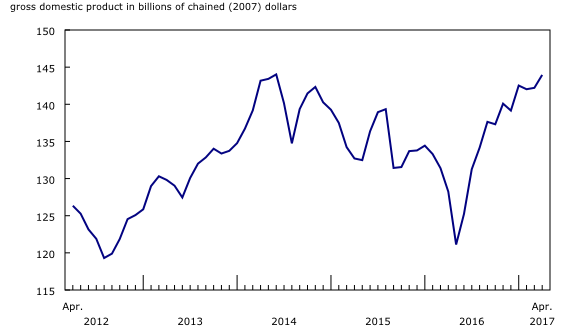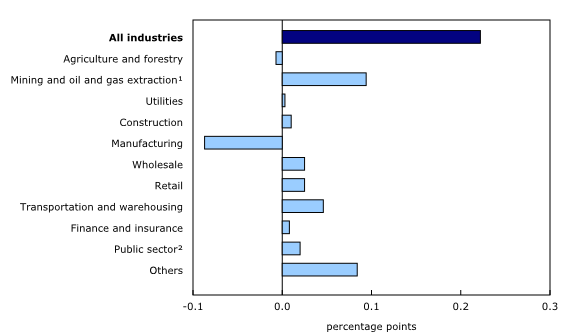Gross domestic product by industry, April 2017
Archived Content
Information identified as archived is provided for reference, research or recordkeeping purposes. It is not subject to the Government of Canada Web Standards and has not been altered or updated since it was archived. Please "contact us" to request a format other than those available.
Released: 2017-06-30
April 2017
0.2% 
(monthly change)
After increasing 0.5% in March, real gross domestic product (GDP) rose 0.2% in April as 14 out of 20 sectors grew.
Service-producing industries increased 0.3% on widespread growth across sectors. Goods-producing industries were essentially unchanged as growth in mining, quarrying, and oil and gas extraction was largely offset by a decline in manufacturing.
Mining, quarrying, and oil and gas extraction continues to grow
The mining, quarrying, and oil and gas extraction sector (+1.2%) grew for the third time in four months in April. Support activities for mining and oil and gas extraction registered double-digit growth for a second consecutive month, increasing 11% as both drilling and rigging services expanded.
Oil and gas extraction declined 0.8% in April as a decrease in non-conventional oil extraction more than offset growth in conventional oil and gas extraction. The decline in non-conventional oil extraction in April was largely the result of ongoing production difficulties at an upgrader facility in Alberta, following a fire and explosion there in March.
Mining excluding oil and gas extraction was up 2.7% in April after declining the previous two months. Metal ore mining grew 2.7% as iron, gold and silver, and other ore mining expanded. Non-metallic mineral mining rose 2.0% following three consecutive decreases, primarily due to higher potash output and exports. Coal mining increased 5.1% as strength in coal exports continued.
Transportation and warehousing gains in April
Transportation and warehousing was up 1.0% in April as a majority of subsectors posted gains. Leading the growth was a 3.3% increase in rail transportation as rail movement of coal, grain and fertilizers, forest products and intermodal freight increased. Pipeline transportation rose 1.6% as transportation of natural gas (+3.1%) and crude oil (+0.2%) grew in part due to higher exports. Air (+2.0%) and truck (+0.8%) transportation were up, while postal services and couriers and messengers services declined.
Wholesale and retail trade continue to grow
Wholesale trade increased for the fourth time in five months in April, with a 0.5% gain. Machinery, equipment and supplies wholesalers (+4.8%) and food, beverage and tobacco wholesalers (+1.6%) accounted for all growth in the sector, while all other subsectors contracted. The largest decline in terms of output was a 1.9% decrease in miscellaneous wholesaling, with the chemical (except agricultural) and allied product and recyclable material industries accounting for most of the decline.
Retail trade grew 0.5% in April as 8 of 12 subsectors increased. With the exception of December, retail trade has risen every month since July 2016. Leading the growth in April in terms of output was a 4.1% increase at clothing and clothing accessories stores which more than offset a decline in March. Building material and garden equipment and supplies dealers posted growth of 3.1%, the largest increase since May 2015. General merchandise stores expanded 1.9% for a fourth consecutive month of growth. Motor vehicle and parts dealers registered a 1.1% decline as activity at new car dealers contracted.
Professional services continues to rise
Activity at professional services grew 0.5% in April. Leading the growth was a 1.5% rise at legal services. Architectural, engineering and related services were up 0.4%, continuing a recovery in this subsector after registering annual declines every year following 2012.
Arts, entertainment and recreation up for the fourth time in five months
The arts, entertainment and recreation sector grew 2.8% in April, up for the fourth time in five months. The increase was primarily the result of a 7.0% gain in performing arts, spectator sports and related industries, and heritage institutions, as five Canadian teams took part in the first round of the National Hockey League playoffs in April and strong professional basketball and baseball attendance continued. The growth was offset in part by a 0.5% decline in the amusement, gambling and recreation industries.
Construction continues to edge up
The construction sector edged up 0.1% in April, rising for a sixth consecutive month. Engineering and other construction rose 1.6%. Non-residential construction edged up 0.1%, as growth in commercial construction was partially offset by declines in public and industrial construction. Residential construction declined 0.9% in April following five consecutive months of growth, as construction of single, double and row houses declined along with home alterations and improvements.
Finance and insurance up slightly
The slight 0.1% increase in finance and insurance came from a 1.6% gain in financial investment services, funds and other financial vehicles. This was largely offset by declines in depository credit intermediation and monetary authorities (-0.2%) and insurance services and related activities (-0.1%).
Manufacturing declines
The manufacturing sector continued its fluctuations since the beginning of 2017 with a 0.9% decline in April, largely offsetting a 1.0% increase in March as 12 of 18 subsectors declined.
Non-durable manufacturing contracted 0.4% as the majority of subsectors were down. The largest contributors to the decline were beverage and tobacco (-9.1%) and petroleum and coal products manufacturing (-1.2%). These declines were offset in part by gains in chemical (+1.2%) and food manufacturing (+0.9%).
Durable manufacturing was down 1.2% as 7 of 10 subsectors contracted. The largest decline among the subsectors was in machinery manufacturing (-2.9%). Transportation equipment manufacturing contracted 1.3% in April, reflecting declines in motor vehicle (-3.3%) and motor vehicle parts manufacturing (-3.2%).
Other industries
Real estate and rental and leasing services edged up 0.1% in April. There was a 0.6% contraction in the real estate agents, brokers and related services industry as home resale activity slowed in Central Canada.
Accommodation and food services were up 1.1% in April after declining 0.2% in March. Food services and drinking places rose 1.3% while accommodation services increased 0.4%.
Utilities edged up 0.1% in April. Natural gas distribution grew 5.3% while electric power generation, transmission and distribution declined 0.6%.
The public sector (education, health care and public administration) edged up 0.1% in April as education and public administration rose, while health care remained unchanged.
Agriculture, forestry, fishing and hunting was down for a fourth consecutive month, declining 0.4% in April.

In celebration of the country's 150th birthday, Statistics Canada is presenting snapshots from our rich statistical history.
Today we look at the Canadian mining and quarrying subsector's evolution and contribution to the economy over the past half-century.
In 1961, mining and quarrying (excluding oil and gas) accounted for 2.9% of Canada's nominal gross domestic product (GDP), a peak that has not been matched since. The subsector's share of nominal GDP dropped most years afterwards, dipping below 1.0% in 1998 and averaging 1.3% since then.
Within the subsector, metal ore mining represented the largest share of the subsector throughout the period from 1961 to 2013, accounting for 77% of the subsector's contribution to nominal GDP in 1961 and 57% in 2013. Conversely, the share of non-metallic mineral mining rose from 18% in 1961 to 32% in 2013. Coal mining's share (which includes export-oriented mines for metallurgical coal and thermal coal mines supplying electric power generation) more than doubled during this period, from 4.7% in 1961 to 10.9% in 2013. The globalization of metal ore production by multinationals and rotation of activities to lower-cost geographic locations have partially contributed to a declining share of metal ore mining in Canada, while new opportunities emerged for non-metallic minerals such as an expansion of potash production and the start of operations of Canada's first diamond mine in 1998.
Note to readers
Monthly gross domestic product (GDP) by industry data at basic prices are chained volume estimates with 2007 as the reference year. This means that data for each industry and each aggregate are obtained from a chained volume index, multiplied by the industry's value added in 2007. Monthly data are benchmarked to annually chained Fisher volume indexes of GDP obtained from the constant-price supply and use tables (SUT) up to the latest SUT year (2013).
For the period starting with January 2014, data are derived by chaining a fixed-weight Laspeyres volume index to the prior period. The fixed weights are 2013 industry prices.
This approach makes the monthly GDP by industry data more comparable with expenditure-based GDP data, which are chained quarterly.
All data in this release are seasonally adjusted. For information on seasonal adjustment, see Seasonally adjusted data – Frequently asked questions.
For more information on GDP, see the video "What is Gross Domestic Product (GDP)?"
Revisions
With this release of monthly GDP by industry, revisions have been made back to January 2016.
Each month, newly available administrative and survey data from various industries in the economy are integrated and result in statistical revisions. Updated and revised administrative data (including taxation statistics), new information provided by respondents to industry surveys, and standard changes to seasonal adjustment calculations are incorporated with each release.
Real-time CANSIM tables
Real-time CANSIM table 379-8031 will be updated on July 17. For more information, consult the document Real-time CANSIM tables.
Next release
Data on GDP by industry for May will be released on July 28.
Products
For more information about monthly national GDP by industry, see the System of Macroeconomic Accounts module on our website.
The User Guide: Canadian System of Macroeconomic Accounts (13-606-G) is also available.
The Methodological Guide: Canadian System of Macroeconomic Accounts (13-607-X) is also available.
Contact information
For more information, contact us (toll-free 1-800-263-1136; 514-283-8300; STATCAN.infostats-infostats.STATCAN@canada.ca).
To enquire about the concepts, methods or data quality of this release, contact Allan Tomas (613-790-6570), Industry Accounts Division.
- Date modified:




